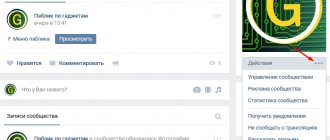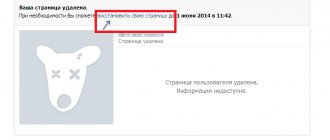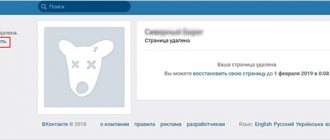Any user can delete their VKontakte page. After this, we will lose access to it and will not be able to see previously published information.
What to do in this case if you urgently need to see some data. By the way, this may also be needed with our old page, which we deleted a long time ago. Can the data be accessed?
There are a number of methods that are aimed at viewing a deleted VKontakte page . They are discussed in detail below.
We use the Web Archive service
There is an old site on the Internet that is a kind of historical repository. There are copies of all the resources that existed on the network.
Well, to be precise, not all of them, and not for all dates. But still, a fairly large array of data. Any user can use it to view long-erased pages. As you guessed, we use this tool to try to open a remote user page on VK.
For example, I will manually delete my test page (see instructions for deleting a VKontakte page).
Her id is “id384697376” (see how to find out a VKontakte user id). When we try to open it on a social network, we will see the following picture.
The page has been deleted - we cannot see the data that was published on it
And we urgently needed to see the last post on the wall. It’s good if the restoration period has not expired - just restore the page and see all the necessary data. What if it’s too late and the profile is completely destroyed? This is where the web archive can help.
The link to the service is below:
https://archive.org/web/
To work with it, I recommend that you use the Opera browser in private mode with VPN enabled. This way you are guaranteed to be able to access it. This is due to the fact that the site is periodically blocked.
I remind you that to enable this mode, open the menu and select the appropriate item. In the new window, activate the VPN function. Hint below.
Being on the start page of the service, we need to enter a link to the desired page into the form. In our example it looks like this:
https://vk.com/id384697376
Enter it into the form and click on the “Browse History” button.
Enter a link to the site in the web archive
Then there are two options for the development of events.
The service has some copies of data related to the specified url address. As you understand, the data may have changed over time. Therefore there may be multiple copies. This can be seen on the timeline at the top of the screen. If there is information for a certain year, you will see the corresponding mark.
Now click on the desired year. Below in the calendar, the date for which there is data will be marked in color. To view the page, just click on this mark.
As you can see, we were able to find a snapshot of the page. This would work even if it were locked and there was no access to it. Now we can see the user's personal data, some photos and wall posts. The goal has been achieved.
But the method does not always work. The web archive does not contain all the pages that exist on the Internet. If there is no copy of the data, we will see a corresponding notification.
No copy of the required page
In this case, you need to move on to the next method.
What VKontakte knows about you
I registered on VKontakte on February 25, 2008 - I received an archive for all 10 years and 9 months of my presence on the social network. The full archive took 85.4 MB. It is divided into the following sections:
- history of name changes, all current information on the page (current at the time of download);
- history of changes in phone number and its binding;
- IP addresses of registration and last logins to your account;
- all sent and received messages in chats and conversations (if the conversations were not deleted);
- likes;
- geolocation of the most frequently visited places (for me this is home and work);
- messages on the “wall”;
- photo albums and photographs, including those in which I am tagged, and comments on them;
- video recordings and comments to them;
- saved audio recordings;
- a list of users I am subscribed to, current subscriptions to publics and groups with special rights marked (group administrator);
- friend requests - both incoming and outgoing;
- “stories”, bookmarks and gifts;
- uploaded documents and added products;
- installed applications;
- imported contacts from email and other social networks;
- a list of accounts that are included in my blacklist;
- contacting technical support;
- payments within the social network.
The archive contains copies of every undeleted photo I have ever posted or been tagged in, even if today they are hidden by privacy settings.
Copies of data in search engines
Each of us uses Yandex and Google. Search engines have one useful feature that can help us with our task. Search engines store data about all pages found in their cache. And we can always view it. If we are lucky, we may be able to find a copy of the deleted user page and see the data we are looking for.
Here again we need a link to the page. We type it into the search bar and work with the results.
First in Yandex
If the search results contain the page you are looking for, pay attention to the line with the Url address. Here, open the drop-down menu and select “Saved copy”. You will be taken to the desired page.
Here the interface is more convenient. You can view graphic materials in full resolution. If you needed to find a photo from a deleted page, you can open and save it.
More comfortable. But, unfortunately, data from long-deleted pages is rarely saved here.
Now on Google
The process is similar here. We are looking for a page at the address. If it exists, look at the saved copy.
And finally, one more working method.
How to read your archive
You can request a file with your data using this link.
|
| To find the link yourself, go to the social network menu - it is located at the bottom left, after the list of your services and advertisements. Click "More" and select "Data Protection" from the drop-down list. After moving to another page, open the “Data Management Procedure” tab and scroll down to the “Upload personal data” section. There you just need to click the “Request archive” button. |
The service shows sections of the archive immediately: information about the page, list of friends and messages; payment history and cards linked to the account; information about you as an advertising consumer; a section with information about calls to support, authorization sessions, etc. At the same time, the service warns that you will have to wait for the data file.
|
| VKontakte did not meet the estimated waiting time of 2 hours: the link to the archive arrived four hours later. |
If you use the social network on the same devices, without entering your password each time, and have forgotten it (we have such people in our editorial office), you will have to strain your memory or change the code word before requesting the archive.
|
| It is possible to send a request for data release only after entering a password. Later, when you receive a link to download the data, you will need to authenticate again - via SMS. |
Trying to find a copy of data in the browser cache
I present this method to you more for a complete understanding of the available methods. It is not as relevant as the previous ones, but sometimes it allows you to access media files from a remote page.
It only works if you visited the desired address through your browser.
The point is to look through the cache and try to find a copy of the data there.
You will need the CacheView program. Direct download link is below.
Open the resulting archive and run the program. An automatic analysis of the existing cache from all browsers will be launched. In the menu, you need to open the “Options” section and check the “Display image files” checkbox.
After completing the analysis, we look for existing data from the VKontakte website. To do this, press Ctrl+F and write “Vk.com” in the search bar. We look through the found lines by double-clicking on them with the mouse cursor. If we want to see the data, we copy the link to the file and follow it.
If you manage to find the desired image or photo, you can save it.
View Browser Cache
Every time you open a website page, your browser saves a copy of it to its history. This is done so that when you open it again, you do not have to download it again via the Internet, but instantly provide you with a ready-made copy. This significantly increases the speed of work.
If you recently visited the user's page, there is a chance that it is in the browser cache and you can view it.
Let's do this using Mozilla Firefox as an example.
Enable offline mode. To do this, open the menu, then the “Development” item, and then check the “Work offline” checkbox.
Now in the address bar of the browser, you need to indicate the URL of the desired page and press “Enter”. If a copy exists, it will be loaded. If not, you will see an error message.
I reviewed all three methods in video format.
Viewing deleted accounts
Today, to view deactivated VKontakte accounts, you will one way or another need to turn to third-party tools. In any possible case, you will also need access to the remote page, namely the user ID.
Within the resource in question, the account can be permanently deleted within 7 months from the date of deactivation. In this case, some of the methods may not work, since the VKontakte profile itself will disappear from the network.
In addition to the above, it is important to note such an aspect as the lifespan of VK pages in various search engines. That is, over a certain period of time, the deleted profile will leave all possible resources in the database of which it was ever entered in order to simplify user search.
Accounts whose privacy settings have been set to block search engines, unfortunately, cannot be viewed, since in this case the profile is not saved on other sites.
Method 1: Yandex Search
First of all, it is extremely important to touch upon such a feature of search engines as automatically saving a copy of the page. Thanks to this feature, you can easily open the user’s page and view the information you are interested in by performing a few simple steps.
Some other search engines, just like Yandex, store data about VK users in their own database. However, Yandex specifically works better than any other similar resource with requests on VKontakte.
- Open the official website of the Yandex search engine in any convenient browser using the special link.
Press the Enter key on your keyboard or use the Find button on the right side of the search field.
Note that you can completely remove the introductory part of the URL used, leaving only the account ID and domain name of the VK site.
Among the search results, if viewing is possible, the first post will be the wanted personal profile.
If you attempt to access the page by directly following the link provided, you will be directed to a notification that your account has been deleted.
To open a previously saved version of your account, next to the shortened link of the desired result, click on the arrow pointing down.
In the drop-down list, select “Saved copy”.
Now you will be presented with the page of the desired user in the form in which it was last available to the Yandex search engine.
Please note that most of the links and various functional elements are in working order. However, this remark is relevant only when the profile is in a deactivated state for a short period of time.
This is where you can finish with this method, since if all the conditions have been met, you will be able to find information about the deleted VK user page without any problems.
Method 2: Google Search
This method, unlike the first, is the simplest in terms of viewing once deleted user profiles. However, despite its simplicity, it has many disadvantages, which boil down to the fact that you do not have the opportunity to view detailed information about the user.
In the Google search engine, as well as in the case of Yandex, discussed above, you can view a once automatically saved copy of the page.
Taking into account the above, VKontakte profiles, after deletion, are quickly excluded from search queries, which is why you will not be able to see the information at any convenient time. This method will be most appropriate only in situations where the person who deleted the page still has a basic recovery opportunity within 7 months.
- Using the provided link, open the main page of the Google search engine.
Go to the VK social network site and copy the URL of the deleted user profile from the address bar of your browser.
You need to get an identifier, and not a unique personal profile address. Otherwise, you most likely will not be able to find information about the page you are looking for.
If in the process of following the recommendations you followed all the instructions exactly, then in the very first lines of the results page you will be presented with a short profile of the person you need.
Often, the results will be reported by third-party resources, and not by the VKontakte social networking site itself.
Now you can finish working with search engines in order to view ever deleted accounts and move on to a more radical method.
Method 3: Web Archive
This method, like the previous one, requires that the user account is not hidden by special privacy settings. This is especially true for search engines, since almost any search on third-party sites has a connection with them.
This method may well be applicable not only to VK, but also to some other social networks.
If the user account fully meets the requirements, you can proceed to use a special service designed to view sites in a previously saved state. It is also important to take into account that not all social pages. VKontakte networks have a previously saved copy.
- While on the VKontakte website, from the address bar of your browser, copy the URL of the user whose information you want to view.
Using the link we provide, open the Internet archive in any web browser convenient for you.
In the center of the main page of the web archive, find the search bar and paste the previously copied profile identifier there using the keyboard shortcut “Ctrl + V” or the browser context menu.
Depending on your privacy settings, you will receive:
- an error message asking you to save the specified URL in the Internet Archive database;
a graph of saved data with the ability to view a copy of the VKontakte site by a specific date.
To start viewing the page, you first need to select the year of interest in the appropriate block.
Now, after automatic updating, scroll down the page a little lower and use the calendar to select the exact date that marked this or that version of the account.
Notice that each number highlight has its own meaning:
- gray – saved profile data is not in the database;
blue – there are one or more records at a certain time of the day;
Depending on the number of entries present on the same day, the circle highlight around the date increases.
By corrupted data we mean those cases when the account cannot be accessed, for example, due to a 404 error.
After following the suggested recommendations, a user page will open inside the Internet Archive site, having the same appearance as it had at the time it was saved in the database.
If you used a copy that was saved before the global update of the VKontakte site, then the early VK interface will be provided for your use.
Using the service, you are viewing accounts on behalf of an unregistered user. However, you cannot log in and, for example, comment on any post.
The main disadvantage of this service is that it displays VK user profiles in English due to the regional settings of the service.
In conclusion to this method, it is important to pay attention to the fact that almost all links in the Internet archive are active and they lead to the corresponding page saved in exactly the same time period. In this regard, you should always remember that not all accounts on the VKontakte social network have suitable copies in the web archive.
Thank the author and share the article on social networks.
For many users, VK is a repository of personal information. Photos with memorable moments, videos from a walk of your company, whose members have long dispersed to different cities and countries. Did you store this on a social network and your page was blocked? Or maybe a friend deleted his profile with valuable information. Don't be upset! All is not lost. You can use the VKontakte web archive.
There is a saying, “What goes on the Internet stays there forever.” It is very close to the truth, because even remote pages on VK and other social networks. networks can be viewed. For this purpose, three working tools are used.











